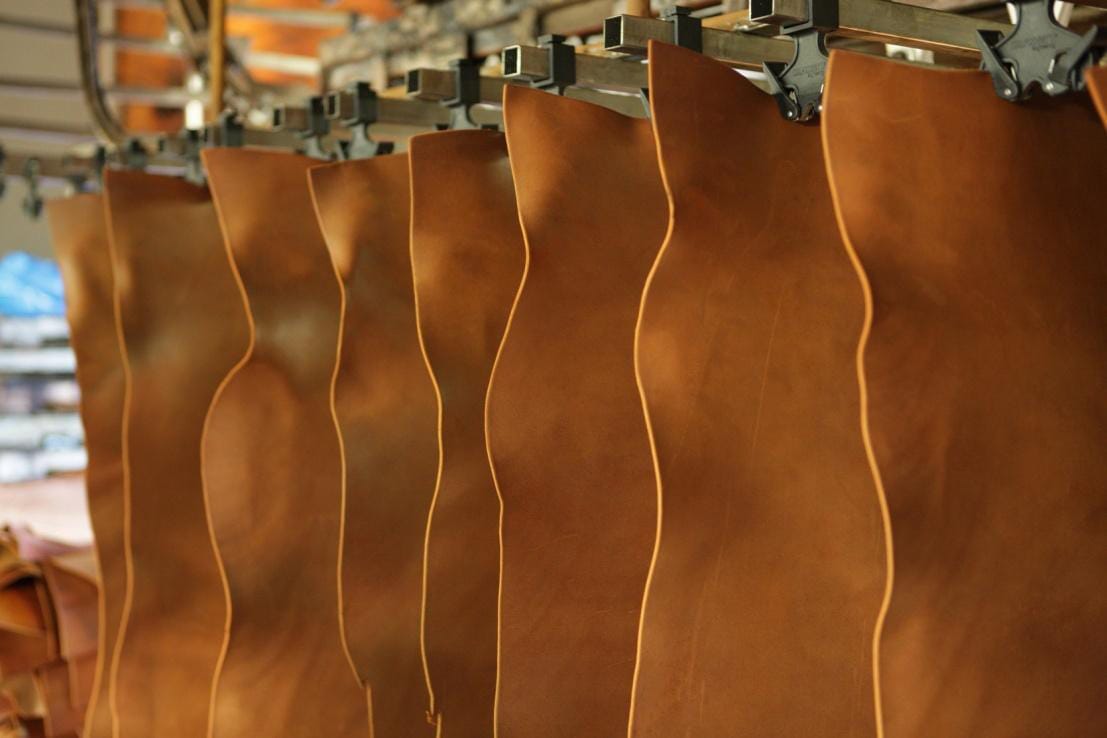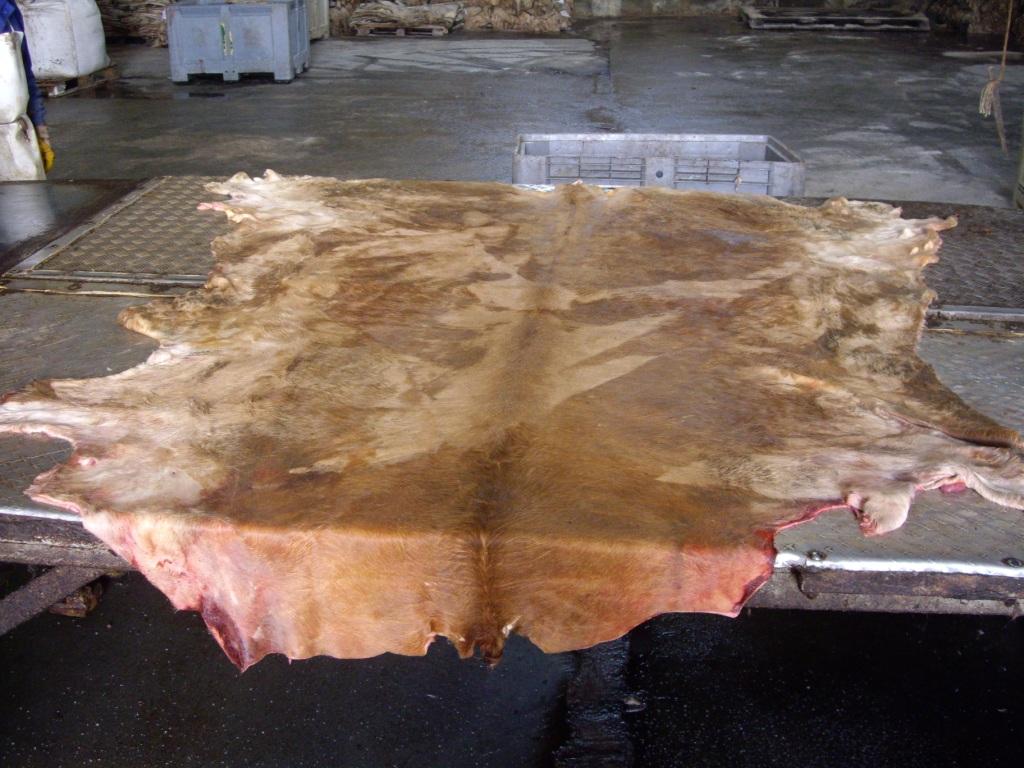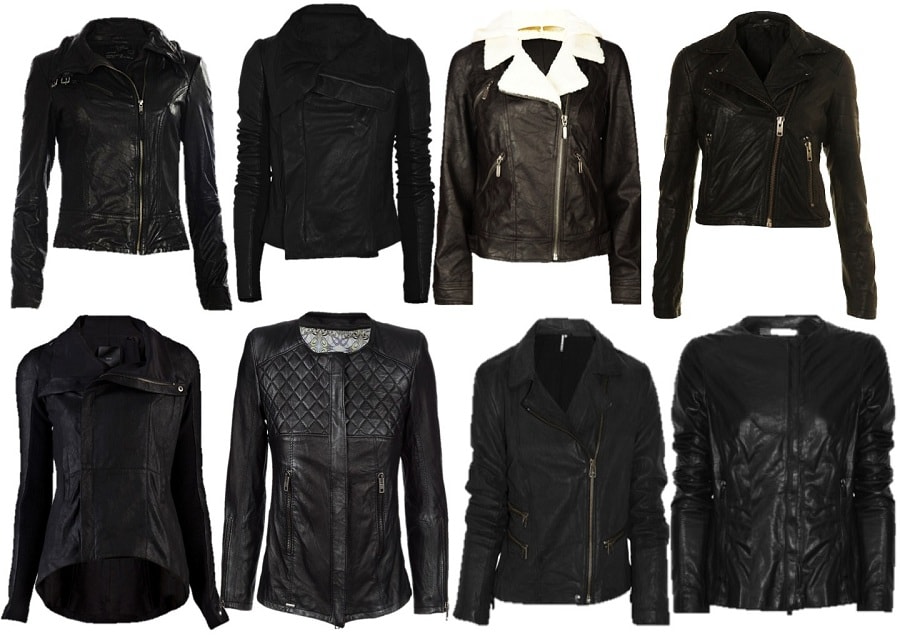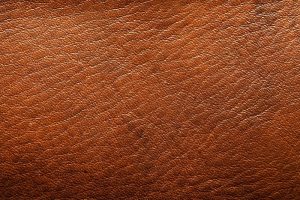How Leather Is Made in 23 Steps

How leather is made hasn’t changed much over the past several thousand years.
That being said, the entire process of making leather available for manufacturing is certainly not simple. In fact, it takes an average of 10 working days to turn hides into leather.
Skilled artisans – known as tanners – are highly knowledgeable, and they perform their duties with the utmost care. The process of leather production is lengthy and complicated, which helps to explain the high retail price tag associated with leather goods.
From a salted hide to a high quality piece of leather, we will show you exactly how leather is made in a total of 23 steps:
1. Curing
Hides, the term applied to animal skins used in leather production, must be preserved in order to prevent deterioration. These preservation methods often involve salting, freezing, chilling, or the use of chemicals.
2. Soaking
Once the hide has been cured, it left to soak in water for several hours – sometimes even days. The objective in this step is to rehydrate the hide, as well as to remove any excess salt or dirt. For instance, unwanted deposits of dirt may have occurred during transportation.
3. Painting
Do not let the term confuse you. When describing how leather is made, painting refers to removing wool from sheepskins using sulphides.
4. Liming
While liming has a number of purposes, the primary function of this step is to remove any unwanted hair from the hide through the introduction of alkali. Once the hair has been removed, we are left with raw animal skin. This is more commonly referred to as a pelt.
5. Fleshing
As the term suggests, fleshing is the process of passing the pelt through a machine that removes any tissue from the flesh side. In some instances, a pelt will also be split into layers at this stage.
6. De-Liming
This step involves the graduate neutralization of alkali in the pelt. It is important that this is done gradually, as a rapid change in acidity could result in tissue distortion.
7. Bating
Enzymes are applied to the pelt, causing it to flatten and relax.
8. Pickling
Tanning requires pelts to be mildly acidic; therefore, pickling involves the application of weak acids or salt solutions. If a pelt is not to be tanned for several months, a strong solution may be applied to act as a preservative.
9. De-Greasing
Just prior to tanning, a pelt must have any excess grease removed with water or a mild solvent.
10. Tanning
Tanning chemically alters the collagen structure of a pelt, such that it is protected against chemicals, moisture, and microorganisms. To put it simply, converting the proteins found in a pelt in a stable material occurs in this step. It is generally done by using:
- Minerals: A mineral, such as salts of chromium, is the most common leather tanning material.
- Oils: When a pelt is tanned with oil, the result is a much softer leather for more fashionable products.
- Vegetables: Plant extracts may be used to produce thick, firm, and brown leather, ideal for belts, shoes, bags, and cases.
Once a pelt has been tanned, it is now considered leather – but there are still several steps to go before it is ready for sale to a manufacturer.
11. Splitting
In this step, a machine is used to slice leather into two layers. One of the resulting layers will be without a grain surface. This piece can be used to produce suede or have an artificial grain surface applied to it.
12. Shaving
With the piece that has a grain surface, another machine is used to shave the non-grain side. This is how leather is made to a desired level of thickness.
13. Neutralization
This step in how leather is made is done to remove residuals from any of the previous chemical applications. Additional tanning materials may also be applied to create a particular style or texture in the finished product.
14. Dyeing
Depending upon the intended use for the finished leather, any number of colours may be applied at this stage. This is how leather is made in black, red, brown, and even white varieties.
15. Fatliquoring
This process involves lubricating the leather with oil to ensure it is both flexible and soft. This is especially important when producing leather for fashion, as the absence of oil will cause the leather to become hard as it dries out.
16. Samming
Moisture must be taken out of the leather before it will be ready for production. Almost half of the water is removed through a number of different machines.
17. Setting Out
The leather is now stretched and the grain surface is smoothed out. In so doing, the moisture remaining in the leather is further reduced.
18. Final Drying
Leather is generally dried until less than 20% water content remains.
19. Staking & Dry Drumming
To ensure that the leather is soft and flexible, it is further massaged in a staking machine. This process separates the fibres. Once complete, the leather is placed inside a rotating drum for extensive tumbling.
20. Buffing & Brushing
The flesh surface of the leather is now totally removed through buffing to produce a softer feel, or simply to reduce the overall thickness. A thorough brushing happens thereafter to remove any dust accumulated during buffing.
21. Finishing
Finishing occurs in leather production to ensure even colour, remove any defects on the grain surface, correct the level of gloss, and to add a protective and water resistant surface.
22. Final Grading
Prior to sale to a manufacturer, the tanner must grade the colour intensity and uniformity of the leather, as well as its feel, softness, thickness, and texture. Any naturally occurring defects, such as scratches, must also be noted during the final grading.
23. Measurement
The final product is now complete! This is how leather is made from start to finish. All that remains in this step is to measure the area of each individual piece, as leather is sold by area. To ensure complete accuracy, measurements are done by machine.
What Do You Think?
Did you ever consider that the leather clothing, accessories, and furniture you enjoy were the result of such painstaking effort?
Can you appreciate the sheer volume of labour involved in producing high quality leather products?
Does this give you a new found appreciation for the skill and talent of tanners worldwide?
And most importantly, can you understand why it is so important that you only entrust your fine leather products to reputable professionals for care?










